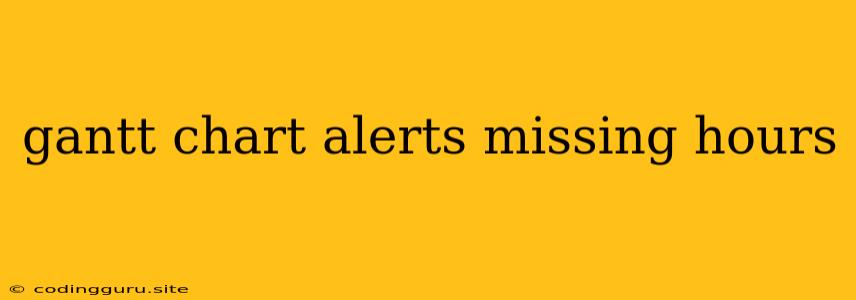Gantt Chart Alerts: Why are Missing Hours a Problem?
Gantt charts are a popular tool for project management, providing a visual representation of tasks, deadlines, and dependencies. But what happens when you notice missing hours in your Gantt chart? This can be a real problem, causing confusion, inaccurate estimations, and potential delays.
Why are Missing Hours a Problem?
Missing hours in a Gantt chart can be a symptom of several underlying issues:
- Incorrect Task Duration Estimates: The most common reason for missing hours is simply that the initial task estimates were inaccurate. Maybe you didn't account for all the necessary steps, underestimated the complexity of the task, or overlooked potential roadblocks.
- Unforeseen Delays: Life happens, and projects are rarely immune to unexpected delays. A team member might be sick, resources might be unavailable, or you might encounter unforeseen technical difficulties.
- Unaccounted for Time: Sometimes, missing hours are simply due to a lack of proper tracking. If team members aren't diligently logging their time, or if you don't have a system for capturing time spent on tasks, it's easy for hours to slip through the cracks.
- Poor Communication: If there's a lack of communication between team members or between team members and project managers, it can be difficult to identify and address missing hours in a timely manner.
How to Solve Missing Hours in Your Gantt Chart
Here's how to tackle the missing hours problem in your Gantt chart:
1. Identify the Root Cause:
- Review Task Estimates: Carefully analyze each task in your Gantt chart. Are the estimates realistic, or do they need to be adjusted based on recent experience?
- Analyze Delays: If you've experienced unexpected delays, determine the root cause. This will help you plan for similar situations in the future.
- Improve Time Tracking: Implement a robust time tracking system. Encourage team members to log their time accurately and regularly.
- Enhance Communication: Ensure that everyone is aware of the project plan and that there are clear channels for communication regarding progress and challenges.
2. Adjust Task Durations:
- Add Missing Hours: Once you've identified the source of the missing hours, adjust the task durations accordingly. This will provide a more accurate representation of the remaining work.
- Reschedule Tasks: If significant missing hours have thrown off the overall project schedule, you may need to reschedule tasks to accommodate the additional time.
3. Implement Alerts:
Many Gantt chart software solutions offer alerts to help you manage time effectively:
- Task Due Date Alerts: Set up alerts that notify you when tasks are nearing their due date. This can help you stay on top of deadlines and avoid falling behind.
- Progress Update Alerts: Configure alerts that remind you to check the progress of specific tasks at regular intervals. This allows you to quickly identify any potential issues and address them before they become major problems.
- Resource Allocation Alerts: Utilize alerts that signal when a resource (e.g., a team member) is becoming overbooked or overloaded. This can help you prevent burnout and ensure that everyone has the time and resources they need to complete their tasks.
Example:
Imagine you're managing a website development project with a Gantt chart. You notice that the "Front-End Design" task has missing hours. Upon investigation, you discover that the designer underestimated the time required for certain design elements. To resolve this, you adjust the task duration to reflect the actual time needed. You also implement an alert that notifies you when the "Front-End Design" task is 50% complete, allowing you to monitor its progress and ensure it stays on track.
4. Track and Monitor Progress:
- Regularly review: Make it a habit to review your Gantt chart frequently, at least weekly, to track progress and identify potential problems.
- Adjust as needed: Be prepared to make adjustments to your Gantt chart as you gather more information and encounter unforeseen circumstances. Flexibility is key to successful project management.
Conclusion
Missing hours in your Gantt chart can be a frustrating issue, but it doesn't have to be a major setback. By identifying the root cause, adjusting task durations, implementing alerts, and staying on top of progress, you can turn missing hours into a valuable opportunity to optimize your project schedule and ensure successful completion. Remember, a well-maintained Gantt chart is a powerful tool for project management.
